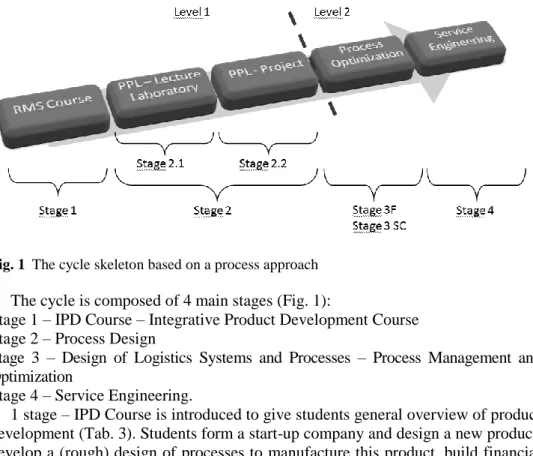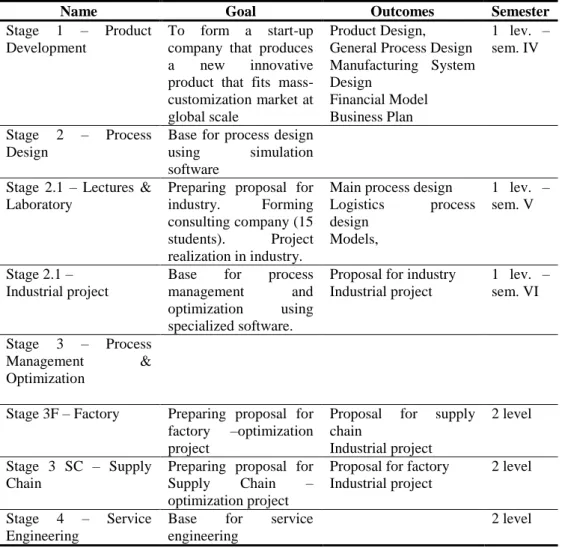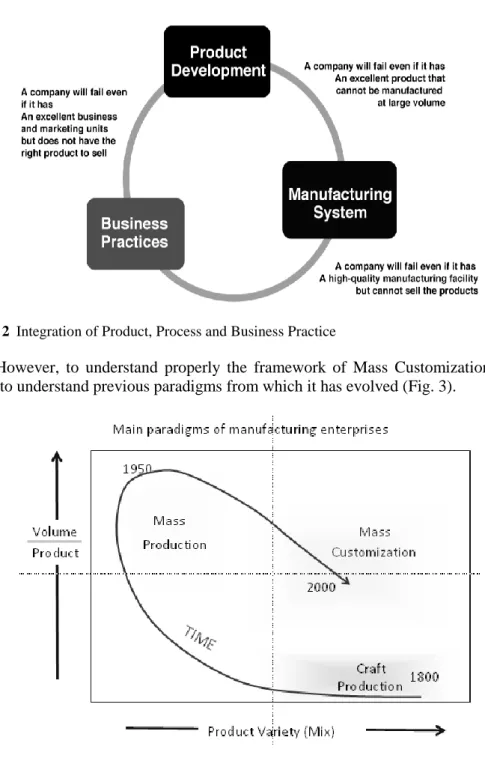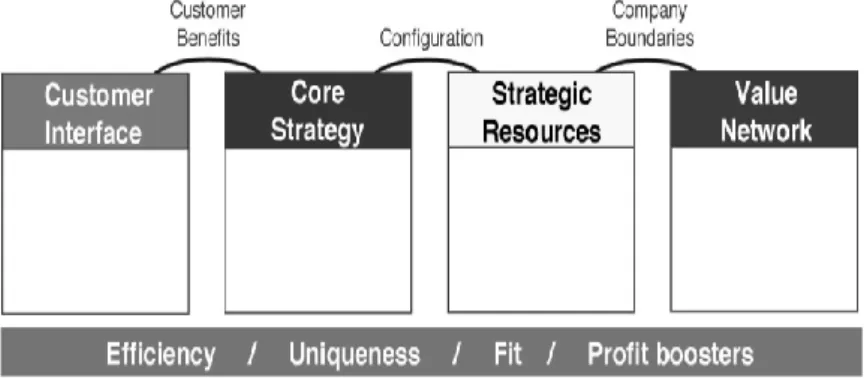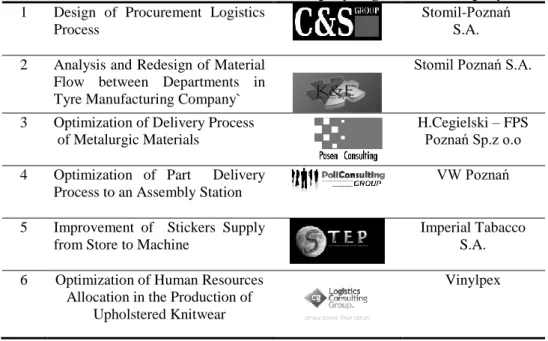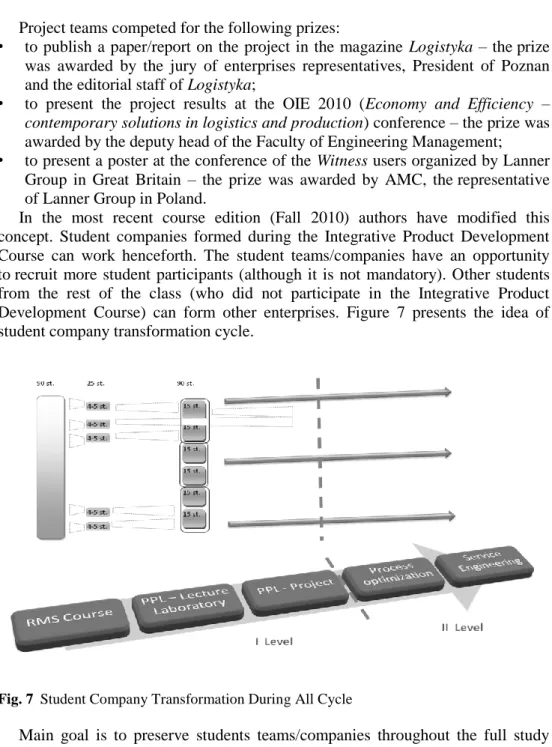LOGISTICS ENGINEERING CURRICULUM
INTEGRATED THROUGH STUDENT PROJECTS
Paweł Pawlewski* and Zbigniew J. Pasek**
* Faculty of Engineering Management, Poznan University of Technology, Strzelecka 11, 60-965 Poznan, Poland, Email: pawel.pawlewski@put.poznan.pl
** Univeristy of Windsor, Canada, Email: zjpasek@uwindsor.ca
Abstract This paper describes an innovative curriculum developed for new Logistics Engineering degree programs at the Faculty of Engineering Management, Poznan University of Technology. The core of the program is based on a sequence of four major courses, which focus on the Product Development, Process Analysis and Optimization, Logistic Processes and Service Engineering. Each course is built around a practical team project. With the project effort as the background, the courses introduce students to key issues in global engineering competence, including collaboration and teamwork, work organization and management, engineering ethics, cross-cultural communication, critical thinking and problem solving, and integration strategies for design, manufacturing and marketing. Projects also introduce entrepreneurial components, as the teams have to develop their concepts in the context of a start-up company. The first course in the series, introduces 2nd year students to basic concepts of consumer product development. It covers the principles of design and innovation process, and also explains essential design tools, such as Quality Function Deployment and Pugh Matrices. It also reviews key manufacturing methods and systems. Students work in small teams to develop their own product ideas from initial concepts to a business plan for a start-up. The course is offered in English. The second course, offered to 3rd year students, introduces fundamental concepts related to industrial process analysis and improvement. Students learn necessary data collection and analysis techniques (such as, for example, Value Stream Mapping) and also the basics of process simulation using a commercial software package. Student teams work with industrial sponsors and develop competing innovative ideas for process transformation and improvement. While the first two courses have already been offered for the first time in the past year in the engineering program (level 1), the third course is still in the planning phase. It will be offered to 4th year students in the first year of their master’s program. It will focus on Supply Chain processes, assessment of their performance, lifecycle analysis and management. The student group project will be carried out in an industrial setting, dealing with real-life assignments. The final course, integrating knowledge acquired by the students in the preceding sequence, is focused on the issues of service engineering. It covers such topics as, for example, organizational design, global issues and design of service operations.
Paper type: Case Study
Published online: 21 April 2011
© 2011 Poznan University of Technology. All rights reserved.
Keywords: Logistics Specialization, Product development, Manufacturing Systems,
Business Practices
1. INTRODUCTION
Among the multiple drivers of the current economy, a few are playing such a significant role as the global trends. Globalization processes imply that not only large companies are becoming global in terms of worldwide distribution of their production facilities, but also that companies must offer an ever changing variety of products to meet customers’ taste and preferences in different countries. This aspect of globalization, together with the e-business opportunities, makes it realistic to create new companies that aim at customization and personalization of consumer products and market them around the globe. Global competition, however, places such businesses under continuous pressure, which may lead to failure, unless they can become highly responsive in three key activities:
1. product development and its market introduction
2. manufacturing system adjustment (correlated to market-driven changes in volume and product switch-over) and
3. reliable and rapid delivery to consumers.
All these characteristics have to be combined with persistent ability to produce products with high quality and at low cost.
Globalization is also driving dramatic changes in the production systems of large companies, which are moving away from mass production methods towards more agile production approaches. Many firms are now striving to offer customers as much variety as it is practical, and to be able to introduce new goods quickly as technologies and customer demands evolve. In other words, they have to achieve production agility and high responsiveness in three domains:
• product design
• product manufacturing and • company organization.
The vertical-integration of manufacturing companies effective in the past, is currently being transformed by concepts of virtual corporation and production networks. While such solutions allow enterprises to focus on their core competencies and better define their brands, they also rely quite heavily on
collaboration and communication, facilitating reliable flow of ideas and goods. In such context design of supply chains and logistic processes grows in importance. There are also other trends worth mentioning, in particular in the context of the most recent global industrial recession, such as:
• growing anti-globalization and protectionist sentiments • de-industrialization of the highly-developed economies.
The extended world-wide effects of recession and what is referred to as a jobless recovery from it, bring into focus the skills that future engineers should acquire in the course of their studies in order to be successful over the lifespan of their professional careers. A good model to pursue in the curriculum updates or development is a T-shaped profile of a future engineer. How such a profile in terms of educational experience should be achieved, is still a matter of an on going debate.
Logistics Specialization at the Poznan University of Technology was launched in 2007-08 academic year. The first class of students has just completed its 6th semester in 2010. This curriculum has 2 levels – in compliance with the European directives defined by the Bologna Process (Chwirot, 2008). First level is 7 semesters long and upon completion students receive the title of an engineer. After completing 3 more semesters (level 2) students earn the master of science in engineering degree.
Graduates of this program are being prepared to become integrators of key activities within an enterprise. They take courses on the design and organization of supply chains, production, transport and distribution of goods. Logistics gains on importance in the context of global enterprises, due to the international trade. This type of knowledge is particularly useful not only in a manufacturing enterprise, but also in retail and services. Well-rounded background of the graduates opens for them opportunities in positions of leadership, management, system analysis, design and consultancies, which can focus on product design, purchasing of goods and services, production, transportation, inventory management, distribution and retail.
2. MINISTRY OF EDUCATION FRAMEWORK
Polish Ministry of Science and Higher Education prepared framework for course Logistics (www.bip.nauka.gov.pl), (www.nauka.gov.pl). The framework defines qualifications of the graduates and contents of needed courses. Table 1 presents a list of major courses for level 1. First level graduate (engineer) should know principles of modern logistics systems, fundamentals of economics, and management.
He/she should have ability to solve logistical issues using engineering methods and technologies, to design logistics systems and processes, to use computer software for logistics management. The graduate should be prepared to work in the environment of a production factory, logistics company, consulting company or administration.
Table 1 Contents of logistics framework for first level program No Content 1 2 3 4 5 6 7 8 9 10
Management of production and services Logistics and Supply Chain Management Logistics Infrastructure
Procurement Logistics Production Logistics Distribution Logistics
Normalization and Quality Management in Logistics Transport Economics
Eco-Logistics Process Design
Table 2 Contents of logistics framework for second level program
No Content 1 2 3 4 5 6 7 8
Production and Services Management Logistics Management
Cost Analysis in Logistics Marketing of Logistics Services
Design of Logistics Systems and Processes Assurances in Logistics
Informatics in Logistics Project Design
The graduates of level 2 should have extended knowledge (in relation to level 1) in scope of company logistics (production, commerce, service) and other organizations forming supply chain. They should be prepared to work in positions of leadership to develop and manage logistics strategies. They should use their knowledge and abilities following ethical and legal rules. They should understand the nature of competition in both local and global markets, mission and goals of company logistics, and significance of quality competition. They should know how to plan, organize and perform logistics processes, to introduce system solutions to improve company management and find reserves to reduce logistics costs. The program graduates should develop good habits to continue their education, to develop professionally and to engage in research. Table 2 presents the list of recommended major courses for level 2.
3. CONCEPT OF NEW CURRICULUM
During the cooperation between Institute of Management Engineering in Poznan (Poland) and University of Windsor (Canada) the new concept to
integrate knowledge from key courses of the Logistics Program has been developed. The main idea is to use courses Process Design from level 1 and Design of Logistics Systems and Processes from level 2 as main foundational courses. Process-based approach allows to think about any company or a factory as structures where processes are performed. Students form teams (companies) and carry out some projects during two levels in continuous, integral way. Student teams work together through the full cycle.
Fig. 1 The cycle skeleton based on a process approach
The cycle is composed of 4 main stages (Fig. 1):
Stage 1 – IPD Course – Integrative Product Development Course Stage 2 – Process Design
Stage 3 – Design of Logistics Systems and Processes – Process Management and Optimization
Stage 4 – Service Engineering.
1 stage – IPD Course is introduced to give students general overview of product development (Tab. 3). Students form a start-up company and design a new product, develop a (rough) design of processes to manufacture this product, build financial model and a business plan. This course is described in details in next section. Stage 2 is divided in two semesters: during the first semester lectures about Process Design are performed and students recognize specialized software for process modeling and simulation. Based on this knowledge during the second semester students prepare proposal for industry, contact with company located in Poznan and perform projects according to order. Students teams offer service to design, model or map real logistics processes. Stage 3 will perform in level 2 and will be divided into 2 specializations: either for a factory (internal) and for supply chain (external). In stage 4 the course Service Engineering will introduce.
Table 3 The process based program curriculum
Name Goal Outcomes Semester
Stage 1 – Product Development
To form a start-up company that produces a new innovative product that fits mass-customization market at global scale
Product Design, General Process Design Manufacturing System Design Financial Model Business Plan 1 lev. – sem. IV Stage 2 – Process Design
Base for process design using simulation software
Stage 2.1 – Lectures & Laboratory
Preparing proposal for industry. Forming consulting company (15 students). Project realization in industry.
Main process design Logistics process design Models, 1 lev. – sem. V Stage 2.1 – Industrial project
Base for process management and optimization using specialized software.
Proposal for industry Industrial project 1 lev. – sem. VI Stage 3 – Process Management & Optimization
Stage 3F – Factory Preparing proposal for factory –optimization project
Proposal for supply chain
Industrial project
2 level
Stage 3 SC – Supply Chain
Preparing proposal for Supply Chain – optimization project
Proposal for factory Industrial project
2 level
Stage 4 – Service Engineering
Base for service engineering
2 level
4. INTEGRATIVE PRODUCT DEVELOPMENT COURSE
The main feature of the course is a class-long project in which students work in teams. Every team consists of up to 5 students, and it is preferred (whenever possible) when each student brings to the team a different background and experience. The team assignment is to create a start-up company offering a new product type that fits mass-customization markets on a global scale (e.g., has potential to be offered on multiple national markets). The team has to (1) develop product idea and its design, including possible product variations, (2) develop
(outline) the manufacturing processes and system necessary to make the product, and (3) prepare a business plan that covers delivery, organization and cost issues.
The course in its current form is designed to run on an intensive schedule for a week and half period. The class meets every day for four time segments, each 1.5 hours long (Table 4); studios refer to hands-on activities. The course is taught in English.
Table 4 Integrative product development course curriculum
Day Topic
1 Intro and overview. Engineering in a global world. Engineering paradigms. Information search & patents. Market characteristics in high- and low-economies. Defining the need: market studies. Customer surveys.
2 Principles of design. Design process and tools. Product invention strategies. Creativity. Studio 1: Paradoxical products. Product concept. (hands-on group work) Design Tools: Quality Function Deployment, Pugh Matrix. 3 Studio 2: Product design. (hands-on group work) Teamwork. Technical
communication: reports and presentations. Modularity & customization. Product development for globalization. Review I: Product concepts. Start-up company identity. (Student presentation)
4 Manufacturing processes. Process selection and planning. Environmental impact. Engineering ethics. Studio 3: Process design (hands-on group work) Manufacturing equipment & automation.
5 Traditional manufacturing systems. Reconfigurable manufacturing. Studio 4: Manufacturing system design. (hands-on group work) Quality and customer experience. Introduction to marketing.
6 Review II: Product manufacturing (Student presentation) Responsive organizations. Responsive business models. Financial models Business plans.
7 Studio 5: Anatomy of a business plan (hands-on group work) Business strategies. Entrepreneurship. Studio 6: Integration. Report writing. (hands-on group work) Globalization & manufacturing strategies
8 Final presentations. (Student presentation) Class summary.
The course is centred around the idea of integration of product development, manufacturing systems and business practices (Fig. 2). Therefore, it adopts a system-based approach, considering not only components (be it machines, processes, or knowledge) necessary in production of consumer goods, but also their interactions and impact on each other. While this idea is perhaps not entirely new, it is also set in context of the current market paradigm of Mass Customization (Chwirot, 2008), (www.bip.nauka.gov.pl), (www.nauka.gov.pl).
Fig. 2 Integration of Product, Process and Business Practice
However, to understand properly the framework of Mass Customization, one has to understand previous paradigms from which it has evolved (Fig. 3).
Fig. 3 Three Main Paradigms of Manufacturing Enterprises
Thus initially, the course reviews evolution of production paradigms and, analyses their enablers, principles and business models. Mass Customization is
presented as a process of producing a wide variety of customized products at mass production cost as a strategy (or a business model) that allows quick response to changes in customer demands. With this background, the course then proceeds to address three primary activities, essential for any manufacturing enterprise: (1) product development, (2) manufacturing, and (3) business and marketing.
Product Development: Product Development is explained as a set of activities
beginning with the identification of a market opportunity and continuing with the (i) design, (ii) manufacturing, and (iii) marketing, sale, and delivery of a product. Customer-driven product development plays an important role in the market. Identification of customer needs is continuously performed by all manufacturers. One of the leading methods is based on the development, collection and analysis of customer surveys (students are asked to go through that exercise within the classroom boundaries). While customer-driven development leads to valuable improvements in existing products, the revolutionary products are usually based on breakthrough ideas and inventions that cannot be uncovered though customer feedback. Thus creativity is an indispensable component of strategy in any enterprise. To address that point, a concept of Paradoxical Products is introduced in the class. The students are then required to come up with similar conceptual ideas on their own.
The product development part of the course is concluded with the discussion of product development process in a start-up company, and a review of the typical phases in any product development:
• Phase 1: Concept assessment (market, product concept, manufacturing, business) • Phase 2: Conceptual product design and product specifications
• Phase 3: Detailed product design and engineering • Phase 4: Testing and refinement
• Phase 5: Production preparations.
Relevance of product architecture in the context of Mass Customization is explored on existing product examples, such as, for example, cellphones or automobiles. The advantages and drawbacks of product modularity (e.g., commonality vs. differentiation) are discussed in the context of cost-effectiveness and timeliness. The issue of available product variations is also covered.
Manufacturing: While primary production paradigms were introduced earlier,
this section of the course provides more detailed technical contents on underlying manufacturing systems. It starts with the Mass Production, where standardized products were produced in very high volumes by dedicated manufacturing systems. In mass production a clear connection between the type of manufacturing system and the business model can be established due to the fact that when prices were lowered, more people could afford to buy the products, resulting in more sales, and therefore greater production at even lower costs and lower prices and so on. Discussion of Mass Production systems creates a background for discussion of current practices based on Lean Manufacturing approaches (Womack J. et al., 1990), but more importantly, also provides a contrasting example necessary for introduction
of manufacturing systems needs for Mass Customization. The advantages and shortcomings of dedicated and flexible system solutions are discussed, leading to introduction of the basic concepts of Reconfigurable Manufacturing Systems (Koren Y. et al., 1999). Reconfigurable manufacturing deals with the issue of how to cope with unexpected future changes in product demand, mix, and product type from the manufacturing system perspective. The manufacturing system should be designed to be adaptable to unexpected changes by altering its structure, including the structure of its machines and controls.
The main challenge in covering the manufacturing issues in a class of 2nd year undergraduate students was their relative inexperience and lack of prior exposure to the issues of manufacturing processes and systems. To fill that gap (not to mention also the vast amount of material that may in any case involve the effort to cover these subjects), the instructors have turned to the resources available on the web in the form of books (turned into webpages) from a series How Products
Are Made <http://www.madehow.com>. These materials contain a few thousands
examples of manufacturing processes for a variety of consumer and industrial products, illustrated and summarized in a relatively non-technical form.
Business and Marketing: In the final phase of the course focus turns to
the business issues. The concept of business models is introduced and defined as a statement of how an idea actually becomes a business that is profitable. The same product or service may be brought to market with several business models. Elements of business models (Fig. 4) are discussed and analyzed based on examples of actual companies (Hamel G., 2002) . The corresponding financial concepts, including drivers of financial performance, Return on Investment, etc. are explained, illustrated with current industry data, and interpreted. Students are required to develop a Business Plan for their class project and carry out corresponding (rough and simplified) financial analysis.
Class Project: Team-based class projects are the primary activity of students’
experience and the main basis for final assessment. The primary focus of the student team projects is the Development of a New Product for Mass-Customization. The student team has to:
• Identify a product whose market share could be significantly increased if designed with variations that fit the needs of various customers (i.e., mass customization), and whose price would be attractive if its production is done with a reconfigurable, flexible manufacturing approach.
• Create a company that produces and sells the product. Develop a corporate identity (a name, logo, etc.) and its organizational structure.
• Write a report in the form of a business plan and evaluate the potential profitability of this company. By contrast to business plans offered in business schools emphasize market analysis and finance models, the focus is primarily on product innovation, product design for mass-customization, and manufacturing systems that can cope with turbulent markets.
In the first part of the project students propose a product, perform Product Design and carry out initial market analysis. They have to describe the product on a fairly detailed technical level (including technical specifications and particular, innovative technologies involved), its advantages over existing, potentially competing products, and how the selected product fits the concept of mass customization. In particular, they have to analyze the number and need for proposed product variations. The market analysis has to include total market value (overall customer needs), the market share expected to be captured, and identification of potential customers.
Examples of products selected by students span a fairly wide range, from products that have low-tech contents, such as, luggage or clothing, to products with high level of technology contents, such as stereo systems or smart automotive mirrors. Other examples of products selected by the students in the past course offerings included wheelchairs, bicycles, special engines, car seats, watches, backpacks, sport equipment, sunglasses, skateboards, office furniture, golf clubs, electronic equipment, and health foods. An example of a product (customizable alarm clock) description is shown in Figure 5.
Fig. 5 Example of Student Project Product: Customizable Alarm Clock
In the second phase of the project, teams focus on designing the manufacturing system to make the selected product. This includes a thorough description of the production system, including the various pieces of equipment, discussion of system configurations, floor layout, and estimates of investment costs. For a particular process design, the teams also explore performance specifications of the production facility, such as production capacity strategies and quality issues. The use of outside suppliers is also discussed (in-house vs. outsourced activities), as well as the size and skills of the necessary workforce.
Finally, the teams focus on the development of an overall vision of the company, describing the company growth goal, and the strategies for achieving this goal (strategies in product design, manufacturing, marketing, etc.). They also address product distribution and delivery methods, use of information technology, and financial issues (best and worst case scenarios in sales vs. expenses projections).
The primary challenge faced by the students preparing the outline of business strategies for their potential company is the fact that it is a start-up venture. Therefore, even though they may be fairly familiar on how to design a typical manufacturing facility, development of a strategy that deals with limited resources available for a start-up creates additional, non-technical constraints that they have to consider. The issues of core competencies (Hamel G. and Prahalad C.K., 1994), supply chain management (in-house vs. outsourcing) (Govil M. and Proth J.M., 2002) and risk management come into play.
All the work of project teams is documented in the form of two intermediate and one final presentations (Table 4). Each team is granted a brief (10 minutes) time slot for its presentation, and followed by a period of critique and discussion. In the future these requirements will be expanded to include corresponding reports (up to 25 pages for the final report, with intermediate reports becoming part of the final, complete report).
Team Forming and Assessment of Collaborative Efforts: Since the class project is the primary and term-long activity involving students, organization and composition of the project teams plays critical role in the course. Teams are formed at the first class meeting and get to work right away. Students are offered some background on the team organization and roles they may play to help them self-organize and divide the workload within teams. Students should preferably have a variety of backgrounds and come from many engineering specialties (e.g., product design, business/marketing, manufacturing) and have prior work experience.
Innovative Use of Video-materials: Many concepts in class are illustrated with
short video clips, most of which come from the largest video depository – YouTube (http://www.youtube.com). The instructors believe that use of visual materials, especially in a class consisting of non-native speakers helps them fill the comprehension gaps. In addition, in a recent offering of the course (summer 2010) students were encouraged to create their own videos. Initially, it was just a brief pre-class video interview, where they had to answer some simple questions regarding their background, motivation to study engineering and their future dream job. A few simple video cameras were also distributed at the beginning of the class to encourage the students to use this medium as a means of communication. Most groups have also produced promotional materials for their products either using video spots or transformed their PowerPoint presentations into animated videos using <Animoto.com>.
Fig. 6 Results From a Student Surveys: A) Comprehension of Material, B) Class Satisfaction
Student Feedback: Overall, student response to the course has been very
positive. The direct student feedback is collected twice during the course of the class: in mid-term and at the class end. Gaging students concerns is important, because the open-ended format of the class (no exams, and project- and participation-based grading) raises concerns in particular with students who have no work experience and are not used to course with such structure. Students play an active role in shaping the future course offerings by openly discussing ways to improve the course and its effectiveness. One of the issues brought up repeatedly
is the question on how to effectively teach creativity. It also turns out that the most valued and popular class activities are those related to any kind of hands-on activities and exercises which illustrate more complex issues.
4. EXPERIENCES AND CONCLUSIONS
Authors have experiences (in June 2010) based on two editions of Integrative Product Development Course and one edition of Process Design (including lecture, laboratory and industrial project). In first edition of Integrative Product Development Course (2009) students formed company once and in next semester they formed another company to offer proposal services. The instructors placed emphasis on preparing the students to offer consulting services in the areas, such as, for example, process design, modelling and simulation in industry. These projects were successfully carried out and students formed six consulting companies, which worked with following local companies: VW Poznan, Imperial Tobacco, Vinylpex, Stomil Poznan and FPS (Table 5).
Table 5 List of Projects Performed in 2009/10 Process Design Course (Edition 1)
No Project Tittle Student
Company Logo
Sponsoring Company 1 Design of Procurement Logistics
Process
Stomil-Poznań S.A. 2 Analysis and Redesign of Material
Flow between Departments in Tyre Manufacturing Company`
Stomil Poznań S.A.
3 Optimization of Delivery Process of Metalurgic Materials
H.Cegielski – FPS Poznań Sp.z o.o
4 Optimization of Part Delivery Process to an Assembly Station
VW Poznań
5 Improvement of Stickers Supply from Store to Machine
Imperial Tabacco S.A. 6 Optimization of Human Resources
Allocation in the Production of Upholstered Knitwear
Project teams competed for the following prizes:
• to publish a paper/report on the project in the magazine Logistyka – the prize was awarded by the jury of enterprises representatives, President of Poznan and the editorial staff of Logistyka;
• to present the project results at the OIE 2010 (Economy and Efficiency –
contemporary solutions in logistics and production) conference – the prize was
awarded by the deputy head of the Faculty of Engineering Management; • to present a poster at the conference of the Witness users organized by Lanner
Group in Great Britain – the prize was awarded by AMC, the representative of Lanner Group in Poland.
In the most recent course edition (Fall 2010) authors have modified this concept. Student companies formed during the Integrative Product Development Course can work henceforth. The student teams/companies have an opportunity to recruit more student participants (although it is not mandatory). Other students from the rest of the class (who did not participate in the Integrative Product Development Course) can form other enterprises. Figure 7 presents the idea of student company transformation cycle.
Fig. 7 Student Company Transformation During All Cycle
Main goal is to preserve students teams/companies throughout the full study cycle. Students can then transform their project work from Stage 2 – Process Design (Table 3) into an Engineering Thesis (necessary to complete 1 level), and later transform it into Master’s Thesis (during the project on level 2).
ACKNOWLEDGEMENTS
The authors want to express their sincere gratitude to Prof. Marek Fertch for his support to develop the new curriculum. Our appreciation also goes to the students who were willing to test the new ideas and brought back a lot of enthusiasm and innovation to the class. Paper was presented in International Conference on Engineering Education, ICEE-2010, July 18-22, 2010, Gliwice, Poland
REFERENCES
"A Mass Market of One", [in:] Special Report, Business Week, Dec. 2, (2002).
Chwirot St., (2008), "Proces boloński w praktyce", [in:] Gazeta Uniwersytecka nr 3(163) 12, Uniwersytet Śląski w Katowicach.
Cox W. M. and Alm R., (1998), "The Right Stuff. America’s Move to Mass Customization", Federal Reserve Bank of Dallas Annual Report.
Govil M. and Proth J.M., (2002), "Supply Chain Design and Management: Strategic and Tactical Perspectives", [in:] Academic Press.
Hamel G. and Prahalad C.K., (1994), "Competing for the Future", [in:] Harvard Business School Press.
Hamel G., (2002), "Leading the Revolution. How to Thrive in Turbulent Times by Making Innovation a Way of Life", [in:] Harvard Business School Press.
Koren Y. et al., (1999), Reconfigurable Manufacturing Systems, Annals of the CIRP, Vol.48/2, pp. 527-540.
Pine B.J., (1999), "Mass Customization. The New Frontier in Business Competition", [in:] Harvard Business School Press, Boston, MA.
Womack J. et al., (1990), The Machine that Changed the World, Harper Perennial. www.bip.nauka.gov.pl/.../redir.jsp?place=galleryStats&id=8624 (accessed Mai 2010). www.nauka.gov.pl (accessed Mai 2010).
BIOGRAPHICAL NOTES
Pawel Pawlewski works as an Assistant Professor at the Faculty of Engineering
Management, Poznan University of Technology. He holds a PhD in Mechanical Engineering, specialization organization of production systems from the Poznan University of Technology. His research interests include organization of manufacturing systems, monitoring of operations management, reengineering and IT application for logistics.
Zbigniew J. Pasek is an Associate Professor at the Department of Industrial
and Manufacturing Systems Engineering at the University of Windsor. He holds a PhD in Mechanical Engineering from the University of Michigan. His research interests include manufacturing systems automation, risk management, health care engineering and informal engineering education. He is a member of IEEE, ASME, SME, and ASEE.
